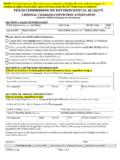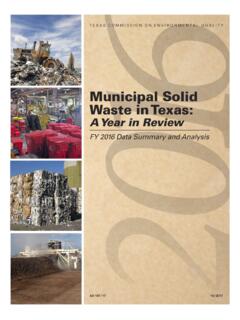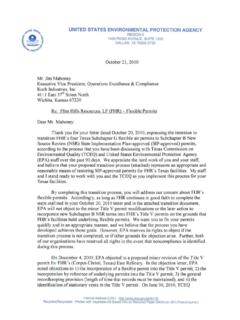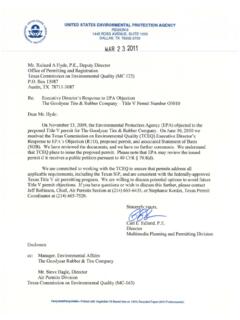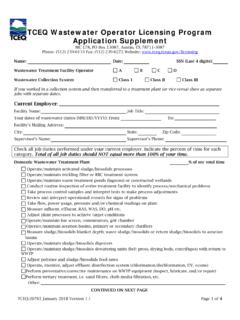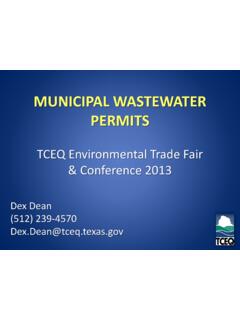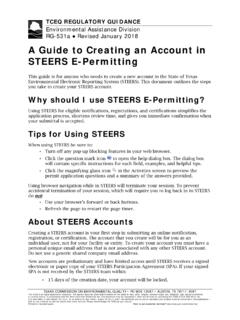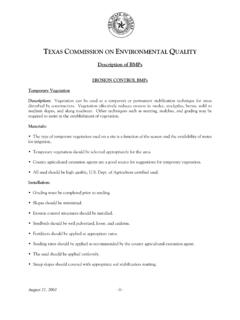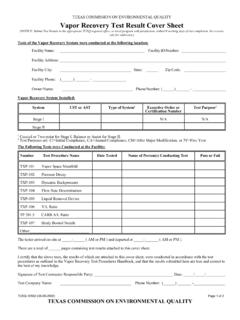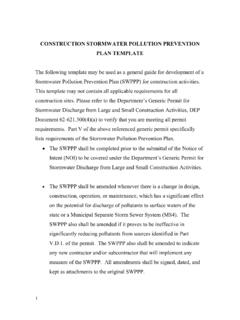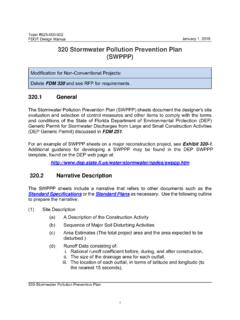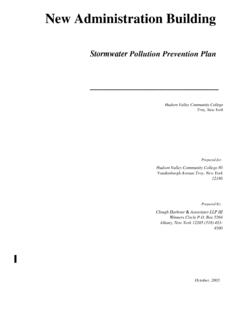Transcription of Texas Pollutant Discharge Elimination System Industrial ...
1 May 2017 Page 1 of 15 Texas Pollutant Discharge Elimination System Industrial stormwater Permit TXR050000 stormwater pollution prevention plan (SWP3) Worksheet Instructions The TCEQ Small Business and Local Government Assistance (SBLGA) Program developed these worksheets to help you develop a stormwater pollution prevention plan (SWP3) under the Texas Pollutant Discharge Elimination System (TPDES), Multi-Sector General Permit (MSGP) for stormwater discharges from Industrial facilities. These worksheets are for guidance purposes only and cannot serve as a substitute for the requirements outlined in Part III (starting on page 52) of the MSGP relating to minimum SWP3 requirements. General Facility Information: Worksheet 1 Limitations on Permit Coverage, Part II Section (page 42 of TXR050000) Your SWP3 must include a short description of the process(es) conducted at your facility and an explanation of any other Industrial activities or facilities at this same location.
2 The SWP3 must also identify bodies of water receiving stormwater discharges from your facility and explain whether or not those discharges may contribute to water quality impairment. Discharges of Pollutant (s) of concern to impaired water bodies where there is a TMDL are not eligible for coverage under this permit, unless they are consistent with the EPA approved TMDL. Additional limitation, conditions, and requirements are applicable to these discharges. Facilities located within the Edwards Aquifer Recharge Zone or Contributing Zone are subject to additional requirements. pollution prevention Team: Worksheet 2 pollution prevention Team Members, Part III Section (page 59) Identify a specific individual or group of individuals within the facility as members of your pollution prevention Team. If the facility is not staffed on a continuous May 2017 Page 2 of 15 basis, an employee from a third party may be identified as part of the team.
3 Additional members of the team may include environmental professionals who are under contract. Examples of pollution prevention Team members within the facility may include, but are not limited to: environmental staff health and safety staff plant or facility operators plant or facility managers Examples of pollution prevention team members from outside the facility may include, but are not limited to: corporate environmental staff corporate health and safety staff regional managers environmental consultants under contract to the facility or corporation Make sure all members of the pollution prevention Team are familiar with the requirements of the MSGP, the facility, and the SWP3 for the facility. pollution prevention Team Responsibilities, Part III Section (page 59) The pollution prevention Team is responsible for the development, implementation, maintenance, and revisions to the SWP3.
4 The SWP3 should clearly define all team members responsibilities. An individual may have multiple responsibilities depending on facility and staff size. Include team members contact phone number with their assignments to give non-team member employees the ability to locate a team member when needed. Examples of duties related to the SWP3 include, but are not limited to: stormwater sampling routine facility inspections rain gauge monitoring SWP3 revisions maintenance of Best Management Practices (BMPs) and erosion controls non- stormwater investigations good housekeeping measures maintenance of exposed inventory lists site map development and maintenance May 2017 Page 3 of 15 spill prevention and response employee training and documentation maintenance of spill and leak log annual comprehensive site compliance evaluation Description of Potential Pollutant Sources: Worksheet 3 Inventory of Exposed Materials, Part III Section (page 59) The pollution prevention Team must develop an inventory of materials currently handled at the facility that may be exposed to rainfall.
5 This list must include all materials that are handled, stored, processed, treated, or disposed of in a manner that allows exposure to rainfall or runoff. The inventory of exposed materials must also include specific pollutants ( oil and grease, copper, wood shavings, etc.) that can be attributed to those materials. It is mandatory to update the inventory within 30 days of a significant change in the types of materials that are exposed to rainfall or runoff, or within 30 days of a significant change in the types of materials exposed to stormwater that were not already included in the inventory. A significant change in material management practices is a change that would either result in initial exposure of a material not already listed in the inventory, or result in an increased exposure of an already listed material. The inventory does not have to include any materials stored in drums, barrels, tanks, and similar containers that are tightly sealed, in good structural condition, and do not have leaking valves.
6 Description of Potential Pollutant Sources: Worksheet 4 Narrative Description of Potential Pollutant Sources, Part III Section (page 60) Develop a narrative description to describe all activities and potential sources of pollutants that may add pollutants to stormwater discharges or that may result in non- stormwater discharges from the facility. Examples of activities and potential sources of pollutants that may be described in this section are: loading and unloading areas (including areas where chemicals and other materials are transferred) outdoor storage areas outdoor processing areas May 2017 Page 4 of 15 dust producing activities on-site waste disposal vehicle and equipment maintenance, cleaning, and fueling areas (including areas where vehicles are stored awaiting maintenance) liquid storage tank areas railroad sidings, tracks, and rail cars potential spill locations location onsite of significant spills and leaks that occurred onsite in the past three years.
7 The narrative description must be updated within 30 days following a change in the types or quantities of materials or in material management practices that may affect the exposure of materials to rainfall. Site Map: Worksheet 5 Site Map, Part III Section & d (page 60) Develop a site map and drainage site map (or maps) that includes the following: the location of each outfall an outline of the drainage area within the facility s boundary for each stormwater outfall connections or discharges to municipal separate storm sewer systems the location of all structures ( buildings, storage, tanks, vehicle storage areas, etc.) structural control devices designed to reduce pollution in stormwater runoff process wastewater treatment units (including ponds) bag house and other air treatment units exposed to rainfall or runoff landfills, scrap yards, surface water bodies (including wetlands) vehicle fueling and exposed maintenance areas physical features of the site that may influence runoff the locations where reportable quantity spills or leaks have occurred during the three years before the Notice of Intent (NOI) for coverage under this permit was submitted process areas, storage areas, or other locations where materials are exposed to rainfall or runoff May 2017 Page 5 of 15 The site map should clearly show the flow of stormwater runoff to each outfall.
8 You may develop a series of maps if the amount of information would cause a single map to be difficult to read and interpret. The site map may be hand drawn and should receive updates as facility changes occur. Figure 1: Example Site Map Description of Potential Pollutant Sources: Worksheet 6 Spills and Leaks, Part III Section & f (page 61) The SWP3 must contain a list of reportable quantity spills and leaks of toxic or hazardous pollutants. A reportable quantity spill is one where the amount of material spilled requires it be reported to the TCEQ at (800) 832-8224 and/or the National Response Center at (800) 424-8802. Regulations concerning reportable quantities can be found at Title 30 Texas Administrative Code (TAC) In the list, describe spills and leaks that occurred during the three years before the NOI was submitted. Also include all other spills within the last five years, even if they were not of reportable quantity.
9 You must update the list quarterly to include additional spills and leaks, if they occur while operating under the MSGP. May 2017 Page 6 of 15 pollution prevention Measures & Controls: Worksheet 7 Best Management Practices, Part III Section (page 62) You must develop a section in the SWP3 that describes the best management practices (BMPs) used to reduce the Discharge and potential Discharge of pollutants in stormwater . In developing BMPs, consider the activities and potentials for contamination identified in Part III, Section of the MSGP, pollution prevention Measures and Controls (Worksheet 3). BMPs, like good housekeeping measures, may be everyday operating procedures that aid in the prevention of exposure of pollutants to stormwater . BMPs may also be structural controls such as covered storage racks. There may be sector specific pollution prevention measures listed in Part V of the MSGP that may be required to be addressed as a BMP.
10 Worksheet 7 allows space to list multiple BMPs at a facility location. Though an exact date is not required, at a minimum, you should list a month and year, or quarter and year to demonstrate advances made in stormwater pollution prevention , and updates made to the SWP3 annually. When developing BMPs, consider the following: storage of materials maintenance programs for equipment and machinery spill prevention and cleanup activities stormwater management equipment standard operating procedures that may have positive effects on Discharge pollution prevention Measures & Controls: Worksheet 8 Good Housekeeping Measures, Part III Section (page 62) Ensure that areas of the facility that contribute or potentially contribute pollutants to stormwater discharges are maintained in a clean, orderly manner. Good housekeeping is one of the most important aspects of stormwater pollution prevention efforts.
